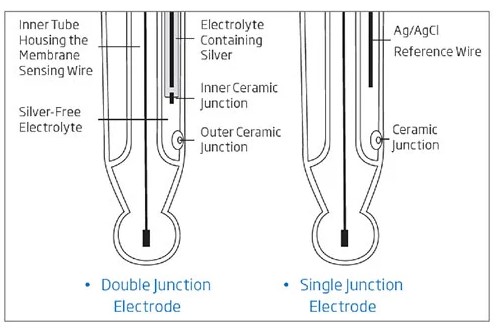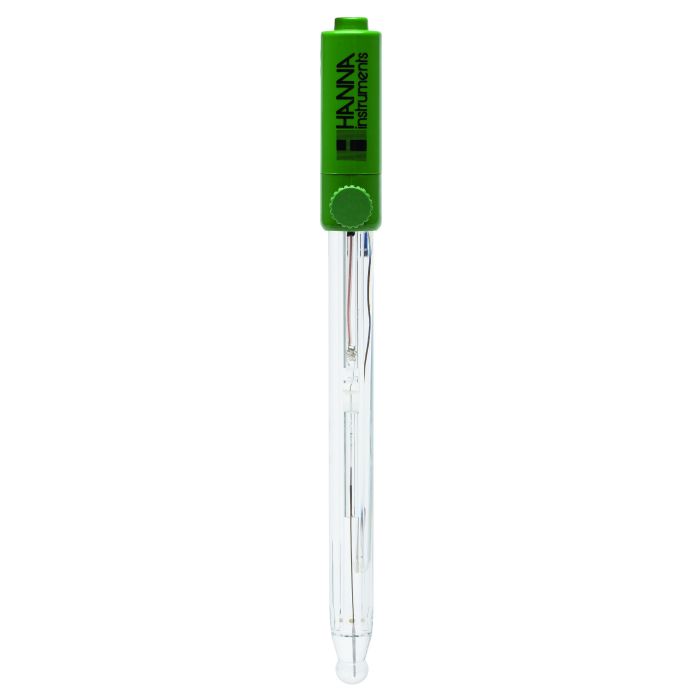Refillable Double Junction pH Electrode with BNC Connector HI1043B
- Refillable Electrode
- Double Junction Design
- High Temperature Glass
Hanna Instruments offers a wide variety of pH electrodes that are designed for many different applications. The type of glass used for sensing pH, bulb shape, body material, type of junction, type of reference and electrolyte used are just some of the design considerations.
The HI1043B uses high temperature (HT) glass, spherical bulb, glass body, double ceramic junction, and is refillable with 3.5M KCl.
High Temperature Glass Formulation
The measurement of pH at very high temperatures is detrimental to the sensitive glass bulb and will shorten the life of it. A pH electrode with general purpose (GP) glass will have a resistance of 100 megaohms at 25°C while the resistance of HT glass is around 400 megaohms at 25°C. As the HI1043B is used at elevated temperatures the resistance decreases and approaches the resistance of GP glass. The HI1043B is suitable to use with samples that measure from 0 to 100°C.
Spherical Bulb
The spherical bulb is for general purpose use. Other tip shapes include conic for penetration and flat tip for surface measurements.
Glass Body
The glass body is ideal for laboratory use. The glass is resistant to many harsh chemicals and is easily cleaned. The glass body also allow for a fast transfer of heat to the internal reference electrolyte. The mV generated by the reference cell is temperature dependent. The faster the electrode reaches equilibrium, the steadier the reference potential.
Ceramic Double Junction Reference
The HI1043B is a double junction design. pH electrodes are available as single junction or double junction. See below for a complete description of the differences. The junction also known as a salt bridge is necessary component of the electrical circuit. The movement of ions must flow through the junction for a steady reading. The outer reference has two ceramic frits. The ceramic is a porous material that is easily fused with the glass body and has a similar expansion coefficient and has a flow rate of 40 to 50 µL/hour of electrolyte. This high flow rate provides faster electrode response and more stable measurement in viscous solutions or samples of low conductivity, such as pure water, where a long stabilization time is often observed.
Refillable
The HI1043B is a refillable probe. Since it is a double junction pH electrode the fill solution is the HI7082 3.5M KCl. This solution does not contain any silver as with single junction electrode. The absence of silver will prevent any silver precipitate from forming at the junction surface and clogging it. Clogging of the junction will result in drifty and erratic readings.
BNC Connector
The HI1043B has a BNC connector. This type of connector is universal in that it can be used on any pH meter that has the female BNC probe input. Other type of connectors include DIN, screw type, T-type, and 3.5mm to name a few. These other types of connectors tend to be proprietary for a particular type of meter and are not interchangeable.
Single Junction Versus Double Junction pH Electrodes

Conventional electrodes are normally single junction. As depicted by the figure above, these electrodes have only a single junction between the internal refernce wire and the external solution. Under adverse conditions, such as high pressure, high temperature, highly acidic or alkaline solutions, the positive flow of the electrolyte through the junction is often reversed resulting in the ingress of sample solution into the reference compartment. If this is left unchecked, the reference electrode can become contaminated, leading to complete electrode failure. Another potential problem with single junction electrodes is the clogging of the junction due to silver chloride (AgCl) precipitation. Silver can be easily precipitate in samples that contain Tris buffer or heavy metals. When the electrolyte solution makes contact with the sample, some AgCl will precipitate on the external face of the junction. The result is drifty readings obtained from the sensor.
Hanna’s double junction system, as the name implies, has two junctions, only one of which is in contact with the sample as shown in the figure. Under adverse conditions, the same tendency of sample ingress is evident. However, as the reference electrode system is separated physically from the intermediate electrolyte area, the contamination of the electrode is minimized. The likelihood of clogging of the junction is also reduced with a double junction electrode since the outer reference cell uses a fill solution that is “silver-free.” Since there is no silver present, there is no precipitate that can form to clog the junction.
Specifications
| Specification Name | Detail |
|---|---|
| SKU | HI1043B |
| Description | refillable, combination pH electrode w/ double junction |
| Reference | e double, Ag/AgCl |
| Junction / Flow Rate | e ceramic, double / 30-40 µL/h |
| Electrolyte | KCl 3.5M |
| Max Pressure | 0.1 bar |
| Range | pH: 0 to 14 |
| Recommended Operating Temperature | 0 to 100°C (32 to 212°F) - HT |
| Tip / Shape | spheric (dia: 9.5 mm) |
| Temperature Sensor | no |
| Amplifier | no |
| Body Material | glass — HT |
| Cable | coaxial; 1 m (3.3’) |
| Recommended Use | hydrocarbons, paints, solvents, sea water, strong acids and bases, high conductivity samples, tris buffer |
| Connection | BNC |


